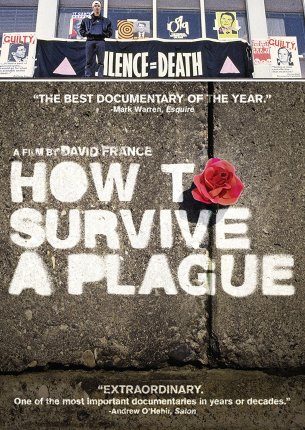 In November 2016, Knopf published David France’s How to Survive a Plague: The Inside Story of How Citizens and Science Tamed AIDS. While I certainly intend to read the book, my nightstand is currently overflowing with volumes. In the meantime, I opted to watch France’s documentary by the same title, which preceded the book by four years and inspired its publication.
In November 2016, Knopf published David France’s How to Survive a Plague: The Inside Story of How Citizens and Science Tamed AIDS. While I certainly intend to read the book, my nightstand is currently overflowing with volumes. In the meantime, I opted to watch France’s documentary by the same title, which preceded the book by four years and inspired its publication.
The documentary covers the period from 1987-1995. As we progress in time, a counter records the number of worldwide AIDS-related deaths from year to year:
1987: 500,000
1988: 800,000
1989: 1.2 million
1990: 1.7 million
1991: 2.4 million
1992: 3.3 million
1993: 4.7 million
1994: 6.2 million
1995: 8.2 million
It was, as Larry Kramer shouts out during an argument with fellow activists, a modern plague. AIDS remains the most deadly pandemic since the 1918 outbreak of the H1N1 “Spanish” flu, which killed up to 5 percent of the world’s population.
How to Survive a Plague tells the story of the trials and triumphs of ACT UP (AIDS Coalition to Unleash Power). In 1987, NYC Mayor Ed Koch decried the group’s “fascist” tactics (e.g., sit-ins, blocking traffic, barricading themselves at government agencies). By 1989, the group’s disruptive methods had yielded institutional recognition, given a speaking position at the International AIDS Conference in San Francisco, and subsequently allowed to sit on NIH research committees.
The film, which is composed primarily of archival VCR footage with no voice-overs and only occasional contemporary interviews, immerses the viewer in the events on screen. We feel the same outrage as activists when in 1989 the Catholic Church takes a doctrinaire position against the use of condoms. We feel the same sense of hopelessness when the two most common drugs for treating AIDS are proved ineffectual in 1993. A prescription for one of the bunk drugs, AZT* (a highly toxic medication that had been abandoned as a cancer treatment due to high fatality rates), had cost as much as $10,000 per year—the most expensive drug in history. Burroughs Wellcome, the manufacturer of AZT, was pulling in profits of $230 million in the late 80s.
As events proceed, a regrettably common story line for minority civil rights organizations begins to take shape: buckling under mounting frustrations over set-backs and failures, the group’s anger turns inward. In the case of ACT UP, some members felt that the group’s Treatment and Data Committee (D&T) had become too cozy with the FDA, NIH, and pharmaceutical manufacturers. They called for a six month moratorium on meetings with drug companies, which, to the members of D&T, was tantamount to quickening death. Inevitably, the group split, with the D&T becoming TAG (Treatment Action Group).
The film tells a complicated story about how best to bring about change in the face of overwhelming structural opposition. While the civil disobedience that marked the early years of ACT UP brought widespread public recognition to the plight of AIDS victims, it was when the group traded in their characteristic black t-shirts and vests for suits and parleys with those in power that demands were translated into action. ACT UP’s activism brought about accelerated FDA approval of new medications, and by giving those infected with the virus a voice in clinical trials and research committees, researchers were able to produce drugs that would halt the replication of HIV by 1996. In so doing, HIV became a chronic condition akin diabetes, one that could not be cured but effectively managed. That such a treatment could be developed in the span of 15 years stands as one of the major victories of modern medical science.
And yet, one can only wonder how many lives might have been saved had organizations like ACT UP not had to force the U.S. government to take action in the first place. Given that Ronald Reagan continues to be lionized with increasing fervor by conservatives with each passing election cycle, it seems unlikely that widespread pubic opinion will ever pass judgment on the inhumanity he showed to AIDS victims. In the minds of many among the “Moral Majority,” all the right people were dying.
*To read the shameful history of AZT, I recommend Celia Farber’s 1989 exposé for SPIN Magazine.